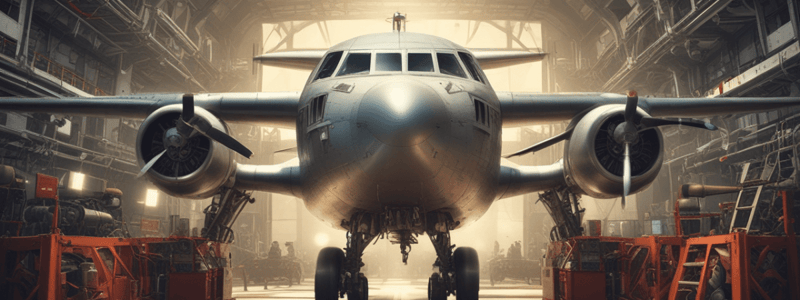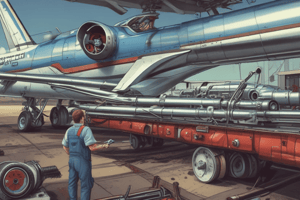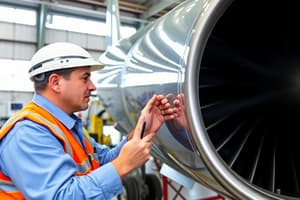Podcast
Questions and Answers
What is the purpose of lubricating quick release terminals with white petroleum jelly?
What is the purpose of lubricating quick release terminals with white petroleum jelly?
- To prevent corrosion forming on the contacts (correct)
- To increase the shelf life of the battery
- To reduce the weight of the battery
- To improve the flow of electrical current
Why must an aircraft battery be securely mounted in the aircraft?
Why must an aircraft battery be securely mounted in the aircraft?
- To make the battery easier to access
- To reduce the risk of the battery becoming dislodged during flight (correct)
- To improve the performance of the aircraft
- To increase the battery's lifespan
What type of nuts are commonly used to secure the battery in place?
What type of nuts are commonly used to secure the battery in place?
- Quick release clamps and hexagonal nuts
- Wing nuts and quick release clamps
- Only hexagonal nuts
- Wing nuts and hexagonal nuts (correct)
What is the first step to take when installing a new battery in an aircraft?
What is the first step to take when installing a new battery in an aircraft?
Why should the positive lead be connected first when installing a battery?
Why should the positive lead be connected first when installing a battery?
What should be checked before installing a new battery in an aircraft?
What should be checked before installing a new battery in an aircraft?
Which terminal of the battery is typically connected to the aircraft structure?
Which terminal of the battery is typically connected to the aircraft structure?
What should be done first when removing a battery from an aircraft?
What should be done first when removing a battery from an aircraft?
What is the main purpose of the reverse current cut-out relay?
What is the main purpose of the reverse current cut-out relay?
What would happen if the reverse current cut-out relay was not used in the generator circuit?
What would happen if the reverse current cut-out relay was not used in the generator circuit?
What is the purpose of the current winding, L4, in the three-unit regulator?
What is the purpose of the current winding, L4, in the three-unit regulator?
What happens to contact C3 when the generator is not operating?
What happens to contact C3 when the generator is not operating?
What is the effect of the coil spring, S3, on the voltage winding, L5?
What is the effect of the coil spring, S3, on the voltage winding, L5?
What happens to the magnetic field of L4 when the generator slows down or the generator voltage decreases?
What happens to the magnetic field of L4 when the generator slows down or the generator voltage decreases?
What is unique about contact C3 compared to C1 and C2?
What is unique about contact C3 compared to C1 and C2?
What is the effect of the charging current passing through L4 on the contacts C3?
What is the effect of the charging current passing through L4 on the contacts C3?
What is the normal operating temperature for the cooling oil?
What is the normal operating temperature for the cooling oil?
How is the oil level typically monitored in a constant-speed drive?
How is the oil level typically monitored in a constant-speed drive?
What happens in the event of an in-flight oil loss or over-temperature condition?
What happens in the event of an in-flight oil loss or over-temperature condition?
What is the purpose of the electrically activated generator-drive disconnect mechanism?
What is the purpose of the electrically activated generator-drive disconnect mechanism?
How can the CSD disconnect be activated?
How can the CSD disconnect be activated?
What happens to the CSD after disconnection?
What happens to the CSD after disconnection?
What is the main function of the hydraulic transmission in an IDG installation?
What is the main function of the hydraulic transmission in an IDG installation?
What components work together to control the power used to drive the alternating current generator?
What components work together to control the power used to drive the alternating current generator?
What is the frequency output of a rotary inverter?
What is the frequency output of a rotary inverter?
What is a major disadvantage of a rotary inverter compared to a static inverter?
What is a major disadvantage of a rotary inverter compared to a static inverter?
What should be done if the control box on top of a rotary inverter appears to be defective?
What should be done if the control box on top of a rotary inverter appears to be defective?
What is the input voltage range for a rotary inverter?
What is the input voltage range for a rotary inverter?
What is an advantage of a static inverter compared to a rotary inverter?
What is an advantage of a static inverter compared to a rotary inverter?
What is the output voltage of a static inverter?
What is the output voltage of a static inverter?
Why are rotary inverters being replaced by static inverters?
Why are rotary inverters being replaced by static inverters?
What feature do rotary inverters have that allows them to automatically start and stop?
What feature do rotary inverters have that allows them to automatically start and stop?
What is the primary source of power for an AC bus?
What is the primary source of power for an AC bus?
What type of systems are supplied power by essential buses?
What type of systems are supplied power by essential buses?
What is the purpose of load shedding in an aircraft?
What is the purpose of load shedding in an aircraft?
What is the function of a Bus Tie Breaker (BTB) in a twin-engine split bus system?
What is the function of a Bus Tie Breaker (BTB) in a twin-engine split bus system?
What is the main difference between a basic DC generation bus system and a basic twin-engine split DC bus system?
What is the main difference between a basic DC generation bus system and a basic twin-engine split DC bus system?
What is the primary purpose of an AC bus system?
What is the primary purpose of an AC bus system?
What is the function of the inverter in a basic DC generation bus system?
What is the function of the inverter in a basic DC generation bus system?
What is the term for non-essential buses that supply power to low-priority electrical systems?
What is the term for non-essential buses that supply power to low-priority electrical systems?
Flashcards are hidden until you start studying
Study Notes
Battery Connections and Installation
- Quick-release terminals are lubricated with white petroleum jelly to prevent corrosion and ensure serviceability.
- Batteries must be securely mounted in the aircraft using a mounting cradle and bolts, and secured with lockwired nuts or clamps.
- Battery installation procedures:
- Ensure the correct type of battery is used, referring to the aircraft maintenance manual.
- Check the mounting tray, box, or compartment and surrounding area are clean and free of corrosion or contamination.
- Check the vent and drain lines are in good condition and not blocked.
- Check the neutralizing jar is serviceable.
CSD/IDG Operation and Indications
- Normal operating temperature for the cooling oil is approximately 93°C (200°F).
- Oil level should be monitored periodically to maintain correct cooling capacity.
- A warning indicator will illuminate on the flight deck in the event of an in-flight oil loss or over-temperature condition.
- The CSD can be disengaged and inspected upon landing.
- The CSD disconnect is switched manually from the aircraft’s flight deck or automatically by a generator control unit.
Generator and Electrical Systems
- IDG installation consists of an alternating current generator and a hydraulic transmission with mechanical control governing the rotational speed of the generator.
- The power used to drive the generator is controlled and transmitted from the aircraft engine through the combined effects of the differential, variable displacement hydraulic units, and fixed displacement hydraulic units.
- The reverse current cut-out relay automatically disconnects the battery from the generator when the generator voltage is less than the battery voltage.
- The AC bus is fed from its respective main generator and supplies power to essential and non-essential systems.
- Load shedding involves isolating non-essential systems during partial generator system failure to prevent overloading the active generator.
DC and AC Bus Systems
- Basic DC generation bus system: a single generator charges the battery and supplies power to the aircraft.
- Basic twin-engine split DC bus system: each generator powers its own individual bus, and if one generator fails, the failed generator is isolated from its bus, and the power on the other bus is coupled to that bus by a Bus Tie Breaker (BTB).
- Basic twin-engine split AC bus system: AC generators supply their individual buses, and fans provide air cooling for the generators.
Inverters
- Rotary inverters:
- Supply 115 V, single-phase or three-phase, or 200 V, three-phase AC power at 400 Hz.
- Have automatic load demand and shut down when the load is removed.
- Disadvantages include lack of frequency control, low surge capability, and lower efficiency.
- Require more scheduled maintenance than static inverters due to mechanical parts.
- Static inverters:
- Serve the same functions as rotary inverters but have no moving parts.
- Are subject to less maintenance problems than rotary inverters.
- Can produce 115 V, single-phase alternating current with a frequency of 400 Hz.
Studying That Suits You
Use AI to generate personalized quizzes and flashcards to suit your learning preferences.



